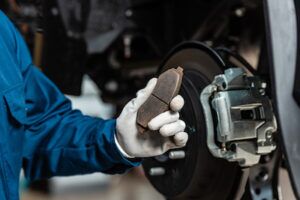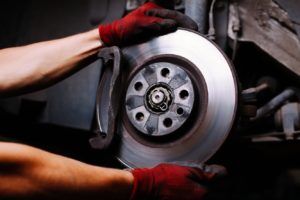Brake Service 101: Essential Elements of Brake Maintenance
Your car’s brake system is crucial for safe stops. Learn what makes this system work.
Brake pads, brake calipers, brake rotors—these critical components and more all contribute to your vehicle’s ability to safely come to a stop. With a name like BRAKEmax Tire & Service Centers, our experience centers heavily around this pivotal system in your vehicle.
Here, we’ll deep dive into all of the different aspects of your vehicle’s braking system and what happens when a brake repair is needed. Our brake service experts also lend their know-how for what to expect during a brake service at any one of our auto shop locations around Tucson.
Common Brake Components
Understanding how your brakes work can help you appreciate just how important they are for the safe operation of your vehicle. This understanding starts with learning about the different components in your braking system are knowing what they are responsible for.
Arguably, the three most important parts of your vehicle’s braking system are:
- Brake pads are a critical part of your
 vehicle braking system. That’s because your brake pads are what physically contact your brake rotors, which produces friction at pressure. It’s this pressure/friction combination being applied to your brake rotors that helps slow and stop your wheels.
vehicle braking system. That’s because your brake pads are what physically contact your brake rotors, which produces friction at pressure. It’s this pressure/friction combination being applied to your brake rotors that helps slow and stop your wheels. - Brake calipers serve as a housing for both the brake pad and the pistons, which makes the function of creating friction on rotors work. Think of the caliper as a hand that’s clamping down around the rotor to make it stop every time you push your brakes.
- Brake rotors: are the metal discs connected into your tire’s hub. Brake rotors work by providing a surface for your brake pads to be squeezed against, which in turn, produces the friction necessary to slow and stop your wheels. Rotors are actually two pieces of metal connected by ribs. This ribbing allows for the heat from the friction of your brake pads to dissipate safely.
It’s important to note, that while there are still a few older vehicles that have drum brakes, almost all cars on the roads today will have a disc brake system at least on their front wheels. Disc brakes are far more efficient and easier to maintain long-term.
Different Types of Brake Pads
Once upon a time, brake pads were made out of asbestos, which is great for dissipating heat, but as it breaks down it releases very dangerous dust. The three most common types of brake pads in use today are metallic brake pads, ceramic brake pads, and organic brake pads. We’ll go into a little more detail on each below.
Metallic Brake Pads
These are the most common types of brake pads on most vehicles today. A mixture of metals like steel, copper, graphite, and bonding materials are used to form the pad. These pads are economical and quite durable, with good performance and heat-dissipating properties, thus making them an ideal all-around choice for brake pads.
Ceramic Brake Pads
Ceramic brake pads are made for high-performance vehicles like race cars because of their superb ability to dissipate heat, their durability, and because they’re lightweight. Commonly composed of ceramic fibers, bonding agents, and often copper fiber, these brake pads provide great stopping power. But their construction also makes them quite expensive.
Organic Brake Pads
Also referred to as “non-asbestos brake pads”, organic brake pads are made from materials like glass, rubber, or resin. These materials have a high heat tolerance and are better for the environment. The downside is that these pads will typically wear down faster than other brake pads.
What to Expect During a Brake Repair & Service Visit
BRAKEmax facilities are stocked with the best tools and parts available to service your vehicle and our technicians are all ASE-certified to be able to service all vehicle types.
While the service performed can somewhat vary from vehicle to vehicle, during a typical brake service visit, our technicians perform the following services:
- Complete visual inspection of the brakes’ friction and hydraulic systems
- If possible, we’ll resurface the rotors and/or drums
- Provide a replacement of high-quality brake pads and shoes, if necessary
- If required, check and repack wheel bearings
At BRAKEmax, we offer a free brake check for drivers in Tucson because this system is simply too vital to the safe operation of your vehicle to ignore.
If you have even the slightest feeling that something isn’t quite right, let us know and our professionals will provide a thorough inspection of your complete braking system.
How Often Should You Get Your Brakes Checked?
The amount of time between having your brakes checked may vary given all vehicles are not the same and everyone’s driving habits are different. Other variables like extreme temperature swings and the hot, arid environment we have here in Tucson can also play a factor.
As a general rule, you should have your brakes checked at least every 6 months, or every 6,000 miles, whichever comes first.
However, if you’re noticing any type of grinding, or squealing, or your vehicle is simply taking longer to stop, it’s a good idea to go ahead and schedule a brake service to have a professional check out what could be causing the issue.
Signs That Brake Service is Needed
Do you have to push down harder on your brakes or notice you don’t have the same stopping power you once did? These are all tell-tale signs it’s time for a brake service. However, there are a lot of other signs to look out for that can give you a warning that something is amiss.
If you are experiencing any of the following issues, you should get your vehicle in for a free brake check at your nearest BRAKEmax facility:
- Hearing any kind of grinding (think metal-on-metal) or squealing when you try to brake.
- Your vehicle’s Anti-Lock Brake System (ABS) light becomes illuminated on your dash.
- You feel your vehicle sway to a certain side after you brake.
- Having to pump or push hard to stop.
- Feeling a “spongy”, hard, or other out-of-the-ordinary feelings when braking.
- Seeing puddles of yellowish brake fluid under your vehicle.
If you have any issues like the above with your brakes, it’s best to get your vehicle in for a free brake inspection as soon as possible. Not having a fully functioning set of brakes is a frightening thought when traveling at highway speeds down I-10 in Tucson.
Where to Get Brake Repair Specials & Discounts
When looking for the best deals on brakes, always be sure to check out the BRAKEmax discounts page. We frequently have different promotions, discounts, and manufacturers’ rebates running, which change frequently.
We also offer a special financing option for holders of the BRAKEmax credit card offered through CFNA finance options. You’ll get low monthly payments that are more manageable when you need an important service, such as brake repairs.
Scheduling Your Brake Repair Service Online
At BRAKEmax, getting your vehicle in and serviced to the highest standards is our absolute priority. We understand most people don’t want to wait around for a long time, even in waiting rooms as nice as ours. That’s why we offer the convenience of online scheduling so that you can show up right when we’re able to get your brake service done.
